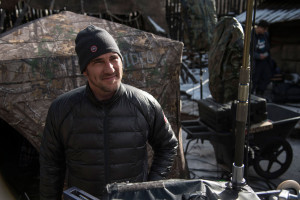
Based on Michael Punke’s novel, The Revenant concerns frontiersman Hugh Glass — played by Leonardo DiCaprio — whose travels in the wilderness involve a vicious attack by a mother grizzly bear protecting her nearby cubs. As such, ILM’s foremost responsibility was realizing a believable computer-animated bear in post-production which would have to interact with DiCaprio’s movements executed on set outside of Calgary, Canada during principal photography.
Initially, McBride met with director Alejandro G. Iñárritu to converse about the idea of staging and animating the bear attack – a central moment in the film. “The very first conversation I had with Alejandro was about the bear,” McBride said. “We got to talking about how we would approach it. He already had some ideas, but he was fairly new to visual effects. How were we going to tell the story of the scene? It was about the reality of the motion and not making it a movie monster, but really making it feel like it was a real animal in its environment behaving like a real animal.”
To research grizzly bear behavior, McBride and his ILM keys looked at a healthy amount of reference footage from YouTube and a documentary about Yellowstone. “There was one quite disturbing video of a guy who falls in a zoo habitat where a bear attacked this guy relentlessly,” McBride related. “We took a lot from that. It’s very focused on what’s in its habitat. This long uncomfortable duration of the attack that goes on and on – there’s no escaping it. We looked at it for all the other nuances: the way the grizzly would go in for the bite and shake and drag the guy.”
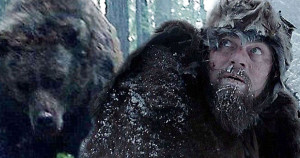 Given the subtleties which he wanted to translate to his computer-generated grizzly, McBride also reviewed materials of regarding how bears stalk their prey. “How they use their snout and mouth and eyes,” he discovered. “They don’t convey emotion, but there’s a lot of expression that’s happening. Getting into the details – the smells, the saliva – they attack the face quite a bit. In our case, mama bear is protecting her cubs. We pulled from all of these sources as an initial starting point.”
Given the subtleties which he wanted to translate to his computer-generated grizzly, McBride also reviewed materials of regarding how bears stalk their prey. “How they use their snout and mouth and eyes,” he discovered. “They don’t convey emotion, but there’s a lot of expression that’s happening. Getting into the details – the smells, the saliva – they attack the face quite a bit. In our case, mama bear is protecting her cubs. We pulled from all of these sources as an initial starting point.”
To develop the particulars of the attack, McBride and the principal photography unit, including the stunt team, assembled the choreography of their scene, much of which is shot in long takes, in spring of 2014. “Chivo [cinematographer Emmanuel Lubezki] and Alejandro brought the camera in,” McBride remarked. “It was an amazing collaboration to set the stage for the visual effects team to have a performance from Leo. We had a good launching point for what our bear would look like. We wanted her to feel quite large, especially compared to Leo.”
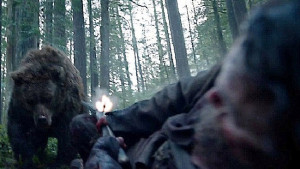 By mid-summer of 2014, the entire company began full rehearsals with DiCaprio in advance of the shoot. “We shot it in October outside of Calgary,” McBride detailed. “We rehearsed out at the location to get a feel for where everything was going to get staged. Leo brought some new ideas: the initial knock down and dragging out. They were quite long sections of the action. We were able to break everything down in a way that made it manageable for costumes and makeup to apply damage.”
By mid-summer of 2014, the entire company began full rehearsals with DiCaprio in advance of the shoot. “We shot it in October outside of Calgary,” McBride detailed. “We rehearsed out at the location to get a feel for where everything was going to get staged. Leo brought some new ideas: the initial knock down and dragging out. They were quite long sections of the action. We were able to break everything down in a way that made it manageable for costumes and makeup to apply damage.”
In large part, the bear attack shoot was pre-planned but for one aspect of location photography. “We had limited shooting light,” said McBride. “It was akin to a live performance. We spent a good part of the day blocking it out. We had a pretty good idea how it would be laid out—we had to be pretty concise. There was one change – a beat where Leo is trying to find a knife; we go towards the bear—she is wounded and suffering herself. We came up with that moment at that time on the set. The bear is conflicted what to do. She has already been shot, but she makes the decision that he’s still a threat.”
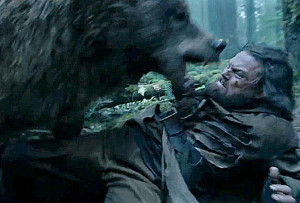 On set, DiCaprio’s actions were largely executed by the film’s stunt team. “They had a big part in it,” McBride revealed, hesitating to reveal the full breadth of the stunt team’s specialized choreography per Iñárritu’s wishes. “They did the heavy lifting. Leo was very much involved in all of it. He bought into being very physical.”
On set, DiCaprio’s actions were largely executed by the film’s stunt team. “They had a big part in it,” McBride revealed, hesitating to reveal the full breadth of the stunt team’s specialized choreography per Iñárritu’s wishes. “They did the heavy lifting. Leo was very much involved in all of it. He bought into being very physical.”
By the end of December 2014, principal photography turned the bear attack plates over to ILM, allowing for them to begin roughing in their computer-generated bear. “We had a rough idea of the length of the entire sequence,” said McBride. “Once it got into the [animation] pipeline, the plates were so long, we spent a lot of time [surveying] the lay of the land before getting the animation going—the animators started composition where she would be.”
Throughout ILM’s extensive process of inserting and animating the bear, McBride was receiving considerable feedback from Iñárritu with regards to the bear’s composition and movement. “We had motion reference to draw from,” McBride explained of his interactions with Iñárritu, which the director mandated. “We had to prove to Alejandro that whatever type of motion we had, we drew from reality.”
Through the first nine months of 2015, ILM endeavored to block in, refine, and finesse final bear shots. “There was a lot of nuance going into the motion and there’s the look of the fur,” McBride commented. “A lot of detailing that took quite a bit of time. I worked with a brilliant team that could be technical but had amazing artistic qualities.”
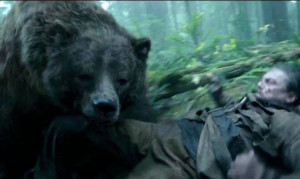 During the nine months of bear animation, McBride conferenced with his artists at ILM’s Letterman Digital Arts Center on the Presidio in San Francisco to work through smaller pieces of shots and individual moments of the bear sequence. “Blocking out for composition,” he noted of the first stage of computer-generated imagery. “Move to refining movement, motion, and speed. I would basically be talking to the team in San Francisco because I was on set. But I would have time with Alejandro, constantly needing to show him updates on things: how the bear was looking. [At first], we had a gray-shaded version of the bear. He preferred [specific shot reviews] to be myself and him or Chivo and myself. Alejandro likes Chivo to be part of the process. They were great collaborators.”
During the nine months of bear animation, McBride conferenced with his artists at ILM’s Letterman Digital Arts Center on the Presidio in San Francisco to work through smaller pieces of shots and individual moments of the bear sequence. “Blocking out for composition,” he noted of the first stage of computer-generated imagery. “Move to refining movement, motion, and speed. I would basically be talking to the team in San Francisco because I was on set. But I would have time with Alejandro, constantly needing to show him updates on things: how the bear was looking. [At first], we had a gray-shaded version of the bear. He preferred [specific shot reviews] to be myself and him or Chivo and myself. Alejandro likes Chivo to be part of the process. They were great collaborators.”
Ultimately, for McBride, the visual effects process was centered around gaining Iñárritu’s trust for each stage of bear placement and animation. “It was such a pivotal scene, he had his eye on everything,” said McBride. “The shooting was difficult: the weather and locations. Making sure that what I was presenting him was always going to be productive. He was always understanding each step of the way. That’s always the difficult thing.”
Lastly, McBride conveyed that a director of a visual effects-intensive sequence—or full film—must have requisite patience for his or her effects team to place computer-based animation in the correct physical location within the shots, then slowly add the details required of each moment. “You can get it 80% there,” said McBride. “Maybe people could fill in that 20%. [Iñárritu] could be a bit reactionary at times with how things were progressing, but it was great that he was part of it every step of the way. I was always making sure that he was part of the process.”





